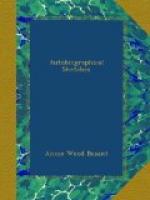At the beginning of August, 1875, the first attempt to deprive me of my little daughter, Mabel, was made, but fortunately proved unsuccessful. The story of the trick played is told in the National Reformer of August 22nd, and I quote it just as it appeared there :—
“PERSONAL.—Mrs. Annie Besant, as some of our readers are aware, was the wife of a Church of England clergyman, the Rev. Frank Besant, Vicar of Sibsey, near Boston, in Lincolnshire. There is no need, at present, to say anything about the earlier portion of her married life; but when Mrs. Besant’s opinions on religious matters became liberal, the conduct of her husband rendered a separation absolutely necessary, and in 1873 a formal deed of separation was drawn up, and duly executed. Under this deed Mrs. Besant is entitled to the sole custody and control of her infant daughter Mabel until the child becomes of age, with the proviso that the little girl is to visit her father for one month in each year. Having recently obtained possession of the person of the little child under cover of the annual visit, the Rev. Mr. Besant sought to deprive Mrs. Besant entirely of her daughter, on the ground of Mrs. Besant’s Atheism. Vigorous steps were at once taken by Messrs. Lewis and Lewis (to whom our readers will remember we entrusted the case of Mr. Lennard against Mr. Woolrych), by whose advice Mrs. Besant at once went down herself to Sibsey to demand the child; the little girl had been hidden, and was not at the Vicarage, but we are glad to report that Mrs. Besant has, after some little difficulty, recovered the custody of her daughter. It was decided against Percy Bysshe Shelley that an Atheist father could not be the guardian of his own children. If this law be appealed




